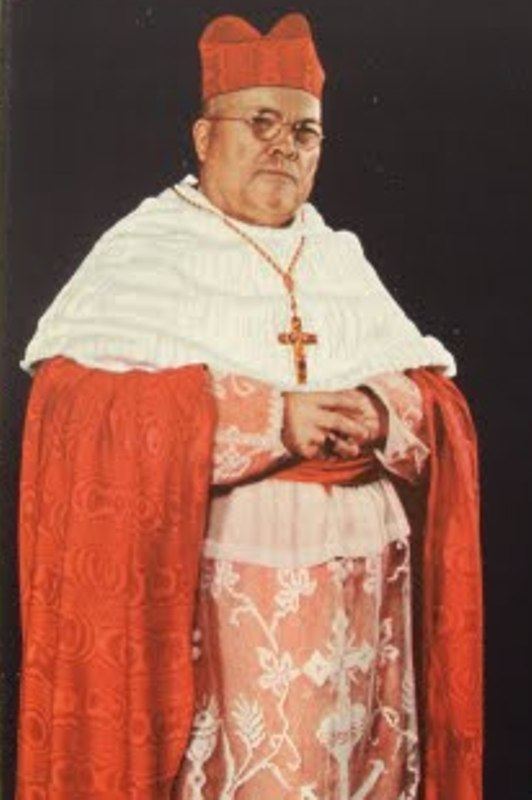See Philadelphia Name Dennis Dougherty Appointed May 1, 1918 | Installed July 10, 1918 Consecration June 14, 1903 Term ended May 31, 1951 Ordination May 31, 1890 | |
 | ||
Died May 31, 1951, Philadelphia, Pennsylvania, United States Predecessor | ||
Dennis Joseph Dougherty (August 16, 1865 – May 31, 1951) was an American prelate of the Roman Catholic Church. He served as Archbishop of Philadelphia from 1918 until his death in 1951, and was created a cardinal in 1921.
Contents
- Early life and education
- Priesthood
- Bishop of Nueva Segovia Jaro and Buffalo
- Archbishop of Philadelphia and Cardinal
- References

Early life and education
Dennis Dougherty was born in Ashland, Pennsylvania, the sixth of ten children of Patrick and Bridget (née Henry) Dougherty. His parents were natives of County Mayo, Ireland; his father worked as a coal miner. The family attended St. Joseph's Church in Girardville, where Dougherty was baptized by Father Michael A. Sheridan. He received the Sacrament of Confirmation from Archbishop James Frederick Wood.
Dougherty, nicknamed "Dinny" by his parents, attended public school in Ashland until age 10, when he transferred to high school in Girardville. He worked as a breaker boy in the local coal mines during his summer vacations. After graduating from high school in 1880, he passed the entrance examinations for St. Charles Borromeo Seminary in Overbrook. However, at age 14, he was considered too young for admission, and was instead sent to Collège Sainte-Marie in Montreal, Quebec, Canada. After studying there for two years, he returned to Pennsylvania and finally entered St. Charles Seminary, where he skipped the first two years of training.
In 1885, Dougherty was sent by Archbishop Patrick John Ryan to continue his studies in Rome at the Pontifical North American College and the Urban College of Propaganda, where he earned a Doctor of Sacred Theology degree in 1890.
Priesthood
On May 31, 1890, Dougherty was ordained to the priesthood by Cardinal Lucido Parocchi in the Archbasilica of St. John Lateran. Following his return to the United States, he became a professor at St. Charles Seminary, where he taught Greek, Latin, French, Hebrew, and dogmatic theology until 1903. In addition to his academic duties, he was also an official of the Archdiocese of Philadelphia, serving as fiscal promotor, prosynodal examiner, and procurator.
Bishop of Nueva Segovia, Jaro, and Buffalo
On June 10, 1903, Dougherty was appointed Bishop of Nueva Segovia, in the Philippines, by Pope Leo XIII. He received his episcopal consecration on the following June 14 from Cardinal Francesco Satolli, with Cardinal Pietro Gasparri and Archbishop Enrico Grazioli serving as co-consecrators, at the Basilica of SS. John and Paul in Rome. Shortly after his arrival, an influenza epidemic swept the diocese. Dougherty turned a number of buildings under his jurisdiction into emergency hospital, staffed by sisters, resulting, according to the Mayor, in "the saving of innumerable lives".
Dougherty faced heavy opposition from Gregorio Aglipay and his followers, known as the Philippine Independent Church, upon arriving in the Philippines. He returned the cathedral in Vigan City, which had hitherto been occupied by the Aglipayans, to the Diocese of Nueva Segovia, and reopened and reconsecrated many churches that had been taken by the Aglipayans as well. Dougherty would also ride on horseback and in canoe to carry out his ministry, which including confirming children, visiting a leper colony, and opening schools and missions. He was named the fifth Bishop of Jaro on April 19, 1908. After twelve years in the Philippines, he returned to his native country upon being made the fifth Bishop of Buffalo, New York, on December 6, 1915. In Buffalo, the Bishop liquidated its $1,100,000 debt on a new cathedral, reorganized Catholic schools and charities, and established fifteen new parishes.
Archbishop of Philadelphia, and Cardinal
Dougherty was appointed the fourth Archbishop of Philadelphia on May 1, 1918. Succeeding the late Edmond Francis Prendergast, he was installed as Archbishop on July 10 of that year. Pope Benedict XV created him Cardinal-Priest of Santi Nereo e Achilleo in the consistory of March 7, 1921, thus making him Philadelphia's first Archbishop to be made a cardinal. Dougherty's voyage to Rome to attend the papal conclave of 1922 was delayed by weather, and he arrived after Pope Pius XI had already been elected. He raised nearly $100,000 to support the Irish in their war for independence.
The Cardinal convinced President Manuel L. Quezon to renounce Freemasonry for Catholicism in 1934, served as papal legate to the thirty-third International Eucharistic Congress in Manila on January 1, 1937, and participated in the conclave of 1939, which selected Pope Pius XII. On behalf of American Catholics during World War II, he once stated, "Like our fellow American citizens we will do our utmost to protect our country by winning the war, and ... to that end we place at the disposal of our government everything in our possession". Dougherty later served as papal legate again to the National Eucharistic Congress in St. Paul, Minnesota, on June 8, 1941. During his thirty-three-year tenure as Archbishop, he oversaw the establishment of 106 parishes, 75 churches, 146 schools, seven nursing homes, seven orphanages, and Philadelphia's Cardinal's Residence, since sold by the archdiocese; he became known as "The Great Builder" for these efforts.
He also held membership in the Congregations for the Sacraments, for Sacred Rites, for the Oriental Church, and for the Propagation of Faith in the Roman Curia, and was once director of the Catholic Total Abstinence Union of America.
On June 24, 1940, he offered the invocation at the opening of the third session of the 1940 Republican National Convention.
Dougherty died from a stroke in Philadelphia, at age 85, shortly after celebrating a Mass marking the sixty-first anniversary of his priestly ordination. He is buried in the Cathedral Basilica of Saints Peter and Paul.
